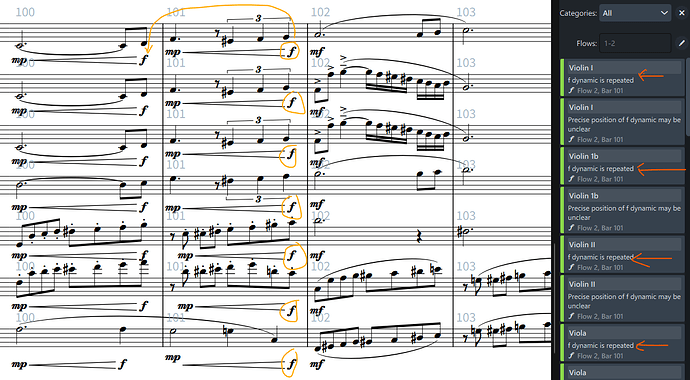I’m using the new Proofreading feature. I get “End position of Pizzicato technique is not explicitly marked.” The Pizz. is created by selecting the range of notes and clicking on "pizz. entry inside Strings of Playing Technique, from Panels.
I dragged the end position of the “line” handle up to the next note, which is already marked as “arco”: the error remained.
I dragged that same ending handle of the pizz. “line” back to the previous note: I got “Return to Arco playing technique following end of Pizzicato is not explicitly marked”.
But if I erase the pizz. entry, select the first note where it belongs, and this time switch to popover mode and enter “pizz.” then … the “error” does away!
Discrepancy in object positioning between Panels and Popover entry modes?
Tks
1 Like
The discrepancy is just whether you have one note selected or multiple notes selected when you create a playing technique. If you have one note selected then Dorico will create a zero-duration playing technique, which is typically what you want. If you have multiple notes selected then it will create a single playing technique with a duration that covers the whole rhythmic range of the selected notes. That can sometimes be useful too, but it’s less common. However, what the proofreading warning is telling you is that you have a playing technique with a duration but it doesn’t have a visible continuation line. This is obviously a bit ambiguous, because the players can’t see where the technique ends.
1 Like
By the way, I just noticed the same problem with dynamics.
Proofreading complains about duplicate
fortes and end of bar 101, but if I delete those dynamics (which were entered via the Panel) and re-enter them as popovers (mp<f), then the errors go away.
Thanks, Richard. I deleted all those playing techniques and dynamics and re-created them from panel lines/entries using your tip and it works fine. I was not aware of that duration aspect. It took this Proofreading feature to draw attention to it and your explanation to clarify and help improve my engraving. Tks!
By the way, this packaging of Proofing rules represents a humongous improvement over the proff-reading plugins I was used to, in Sibelius. Kudos to the Dorico team!
1 Like
It think this is splitting hairs. If an articulation ends, no matter which method is used, it seems that the proofreader should be able detect whether a range of notes was selected and thus the begin and ending markers. However, I did redo using the popover and it fixed the issue as you noted.

